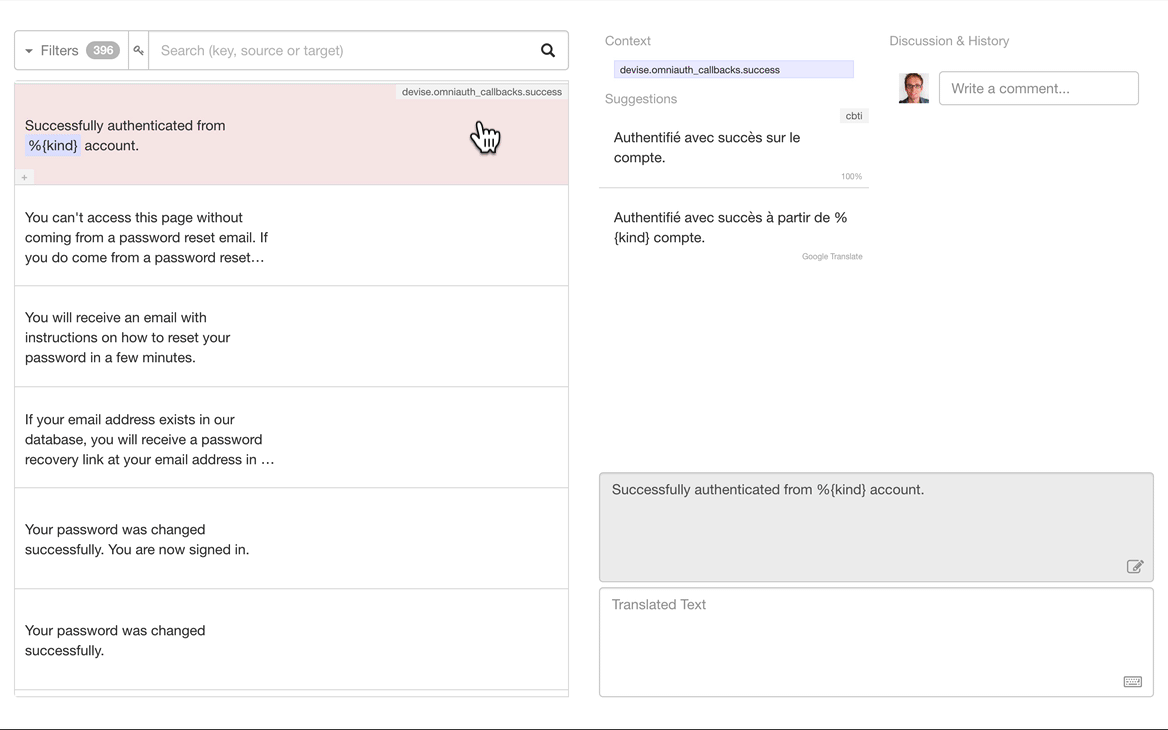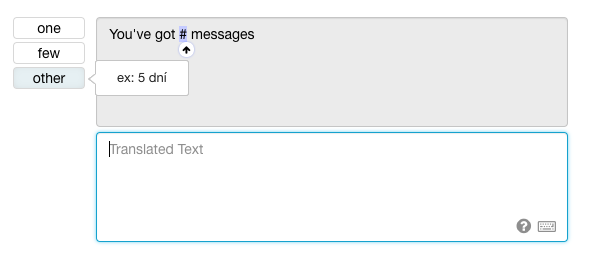Translation.io client for React & JavaScript (using Lingui)
Add this package to localize your React, React Native or JavaScript application.
Use this <Trans>React syntax</Trans>
or this t`JavaScript syntax` .
Write only the source text, and keep it synchronized with your translators on Translation.io.

Important Information:
-
The Translation.io client is directly integrated into the excellent Lingui internationalization framework.
-
This repository only provides additional documentation and a useful meta-package to simplify the Lingui installation. You can refer directly to the Lingui documentation for more advanced Lingui features.
-
The
contextattribute (introduced in Lingui v4) will only work with our intergration if you use version >= 4.11.2 of @lingui/cli. If you are still on earlier versions of @lingui/cli, theidattribute can be used to pass context to your translators.
Need help? [email protected]
- Localization syntaxes
- Installation
- Usage
- Manage Languages
- Change the current locale
- Dynamic loading of .JS translation catalogs
- List of clients for Translation.io
- Contributing
- License
import { Trans } from "@lingui/macro"{/* Regular */}
<Trans>
Text to be translated
</Trans>
{/* Variable Interpolation */}
<Trans>
Hello {name}
</Trans>
{/* Comment for translators */}
<Trans comment="Acronym for Key Performance Indicator">
View KPIs
</Trans>
{/* Simple HTML Tags: translators will see "Text with <0>HTML</0> tags" */}
<Trans>
Text with <em>HTML</em> tags
</Trans>
{/* Complex HTML Tags: translators will see "Text with a <0>link</0>" */}
<Trans>
Text with a
<a href="https://google.com" target="_blank">link</a>
</Trans>
{/* Context: to help translators and allow different translations for the same source text */}
{/* ⚠️ Only works with versions >= 4.11.2 of @lingui/cli */}
<div>
<Trans context="romantic meeting with someone">
Date
</Trans>
<Trans context="a moment in time">
Date
</Trans>
</div>
{/* Explicit IDs: to have more control over the structure of your localization keys */}
{/* ⚠️ In versions < 4.11.2 of @lingui/cli, IDs were used as a way to pass context */}
<div>
<Trans id="index.header.title">
Dashboard
</Trans>
<Trans id="modal.buttons.cancel">
Cancel
</Trans>
</div>N.B. Attributes (comment, context, id) can be used together.
import { Plural } from "@lingui/macro"{/* Regular */}
<Plural
value={count}
one="You've got 1 message"
other="You've got # messages"
/>
{/* Custom plural forms */}
<Plural
value={count}
_0="Your inbox is empty!"
_42="You've found the ultimate answer"
one="You've got 1 message"
other="You've got # messages"
/>
{/* Variable interpolation */}
<Plural
value={count}
one={`Hello ${name}, you've got 1 message`}
other={`Hello ${name}, you've got # messages`}
/>
{/* HTML tags */}
<Plural
value={count}
one={<Trans>You've got <strong>1</strong> message</Trans>}
other={<Trans>You've got <strong>#</strong> messages</Trans>}
/>Note: English has only 2 plural forms (one and other), but other languages
have more of them, from this list: zero, one, two, few, many,
other.
On Translation.io, your translators will see the correct list of plural forms directly in the interface, with examples in their target language:

You can find the complete list of plural forms and plural rules here: available languages and plural forms
import { t } from "@lingui/macro"// Regular
t`Text to be translated`
// Variable Interpolation
t`Hello ${name}`
// Comment for translators
t({
comment: "Acronym for Key Performance Indicator",
message: "View KPIs"
})
{/* Context: to help translators and allow different translations for the same source text */}
{/* ⚠️ Only works with versions >= 4.11.2 of @lingui/cli */}
t({
context: "romantic meeting with someone",
message: "Date"
})
t({
context: "a moment in time",
message: "Date"
})
{/* Explicit IDs: to have more control over the structure of your localization keys */}
{/* ⚠️ In versions < 4.11.2 of @lingui/cli, IDs were used as a way to pass context */}
t({
id: "index.header.title",
message: "Dashboard"
})
t({
id: "modal.buttons.cancel",
message: "Cancel"
})import { plural } from "@lingui/macro"// Regular
plural(count, {
one: "You've got 1 message",
other: "You've got # messages"
})
// Custom plural forms
plural(count, {
_0: "Your inbox is empty!",
_42: "You've found the ultimate answer",
one: "You've got 1 message",
other: "You've got # messages"
})
// Variable interpolation
plural(count, {
one: `Hello ${name}, you've got 1 message`,
other: `Hello ${name}, you've got # messages`
})Note: English has only 2 plural forms (one and other) but other languages
have more of them, from this list: zero, one, two, few, many,
other.
Translators will have the correct list of plural forms proposed directly in the interface, with examples in their target language:

You can find the complete list of plural forms and plural rules here: https://translation.io/docs/languages_with_plural_cases
Quick way to install Lingui with the correct dependencies.
# NPM
npm install @translation/lingui
# Yarn
yarn add @translation/linguiMore complex but cleaner install, with some packages in development only.
# NPM
npm install --save-dev @lingui/cli @lingui/macro
npm install --save-dev @babel/core babel-plugin-macros
npm install @lingui/react# Yarn
yarn add --dev @lingui/cli @lingui/macro
yarn add --dev @babel/core babel-plugin-macros
yarn add @lingui/reactAdd these lines to your package.json to make your life easier.
{
"scripts": {
"sync": "lingui extract --overwrite && lingui compile",
"sync_and_purge": "lingui extract --overwrite --clean && lingui compile"
}
}Create your new project from the UI and select the correct source and target languages.
Copy the .linguirc configuration file that was generated for you to the
root of your application.
The configuration file looks like this:
{
"locales": ["en", "fr", "nl", "de", "es"],
"sourceLocale": "en",
"catalogs": [{
"path": "src/locales/{locale}/messages",
"include": ["src"]
}],
"format": "po",
"service": {
"name": "TranslationIO",
"apiKey": "abcdefghijklmnopqrstuvwxyz012345"
}
}For React (cf. React Documentation or React Native documentation):
import { i18n } from '@lingui/core'
import { I18nProvider } from '@lingui/react'
import { en } from 'make-plural/plurals' // Plural rules for English
import { messages } from './locales/en/messages' // English catalog of translations
import Inbox from './Inbox'
i18n.loadLocaleData('en', { plurals: en })
i18n.load('en', messages)
i18n.activate('en')
const App = () => (
<I18nProvider i18n={i18n}>
<Inbox />
</I18nProvider>
)For JavaScript (cf. documentation):
import { i18n } from '@lingui/core'
import { en } from 'make-plural/plurals' // Plural rules for English
import { messages } from './locales/en/messages' // English catalog of translations
i18n.loadLocaleData('en', { plurals: en })
i18n.load('en', messages)
i18n.activate('en')Localize your app using the <Trans>React syntax</Trans>
or the t`JavaScript syntax` .
Run the following commands to push your source keys and existing translations to Translation.io:
# NPM
npm run sync
# Yarn
yarn syncIf you need to add or remove languages in the future, please read this section about that.
To send new translatable strings and get new translations from Translation.io, and at the same time generate the minified Javascript catalog files, simply run:
# NPM
npm run sync
# Yarn
yarn syncIf you need to remove unused strings from Translation.io, using
the current branch as reference, use the --clean option.
# NPM
npm run sync_and_purge
# Yarn
yarn sync_and_purgeAs the name says, this operation will also perform a sync at the same time.
Warning: all strings that are not present in the current local branch will be permanently deleted from Translation.io.
You can add or remove a language by updating "locales": [] in your
.linguirc file, and syncing your project again.
If you want to add a new language with existing translations (ex. if you already have a translated PO file in your project), you will need to create a new empty project on Translation.io and init it for the first time again.
To edit existing languages while keeping their translations (e.g. changing from en to en-US).
- Create a new project on Translation.io with the correct languages.
- Adapt
.linguirc(new API key and languages) - Adapt the language code in the PO directory structure, and also the language header in PO files.
- Sync your project for the first time and check that everything went fine.
- Invite your collaborators in the new project.
- Remove the old project.
Since you created a new project, the translation history and tags will unfortunately be lost.
Custom languages are convenient if you want to customize translations for a specific customer or another instance of your application.
A custom language is always be derived from an existing language. Its structure should be like:
`${existingLanguageCode}-${customText}`where customText can only contain alphabetic characters and -.
Examples: en-microsoft or fr-BE-custom.
Language fallbacks will work as expected for any regional or custom
language. It means that if the en-GB translation is missing,
then it will fallback to en. So you only need to translate keys that
are different from the main language when you specialize a language.
Note that fallbacks are chained, so en-US-custom will fallback to en-US that will
fallback to en.
You can find more information about Lingui fallback configuration here.
You can change the current locale by using:
import { i18n } from '@lingui/core'
import { en } from 'make-plural/plurals'
import { messages } from './locales/en/messages.js'
// [...]
i18n.loadLocaleData('en', { plurals: en })
i18n.load('en', messages)
i18n.activate('en')You may be able to detect the default locale of the user, based on many things like navigator meta tags, HTML language tag, subdomain, path, cookie, etc.
The easiest way to do that would be to use the small
@lingui/detect-locale package.
import { detect, fromUrl, fromStorage, fromNavigator } from "@lingui/detect-locale"
// can be a function with custom logic or just a string, `detect` method will handle it
const DEFAULT_FALLBACK = () => "en"
const result = detect(
fromUrl("lang"),
fromStorage("lang"),
fromNavigator(),
DEFAULT_FALLBACK
)
console.log(result) // "en"You will find more information about this package here
It’s your responsibility to load the correct translation catalog based on the active locale.
There is a clean dynamic loader helper that will assist you with this task.
// i18n.ts
import { i18n } from '@lingui/core';
import { en, cs } from 'make-plural/plurals'
export const locales = {
en: "English",
cs: "Česky",
};
export const defaultLocale = "en";
i18n.loadLocaleData({
en: { plurals: en },
cs: { plurals: cs },
})
/**
* We do a dynamic import of just the catalog that we need
* @param locale any locale string
*/
export async function dynamicActivate(locale: string) {
const { messages } = await import(`./locales/${locale}/messages`)
i18n.load(locale, messages)
i18n.activate(locale)
}Please read more about this loader here.
The following clients are officially supported by Translation.io and are well documented.
Some of these implementations (and other non-officially supported ones) were started by contributors for their own translation projects. We are thankful to all contributors for their hard work!
Officially supported on https://translation.io/rails
- GitHub: https://github.com/translation/rails
- RubyGems: https://rubygems.org/gems/translation/
Credits: @aurels, @michaelhoste
Officially supported on https://translation.io/laravel
- GitHub: https://github.com/translation/laravel
- Packagist: https://packagist.org/packages/tio/laravel
Credits: @armandsar, @michaelhoste
Officially supported on https://translation.io/lingui
Translation.io is directly integrated in the great Lingui internationalization project.
- GitHub: https://github.com/translation/lingui
- NPM: https://www.npmjs.com/package/@translation/lingui
Officially supported on https://translation.io/angular
- GitHub: https://github.com/translation/angular
- NPM: https://www.npmjs.com/package/@translation/angular
Credits: @SimonCorellia, @didier-84, @michaelhoste
If you want to create a new client for your favorite language or framework, please read our Create a Translation.io Library guide and use the special init and sync endpoints.
You can also use the more traditional API.
Feel free to contact us on [email protected] if you need some help or if you want to share your library.
This is a dumb meta-package that doesn't need any contribution.
If you want to contribute, please refer to the official Lingui CONTRIBUTING.md file.
This meta-package is released under MIT license.
The Lingui MIT License is located here here
